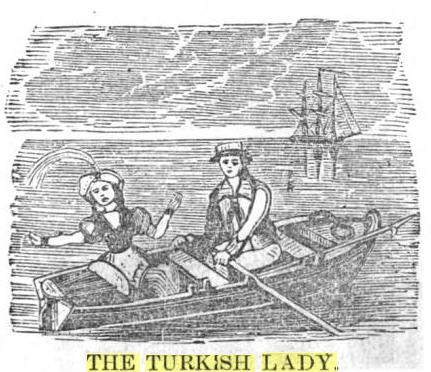53A. The Turkish Lady (Appendix)
[I've included The Turkish Lady as an Appendix to Child No. 53 since the theme is almost the same. Rare is the version by J.E. Mainer and his Mountaineers c. 1970 of "The Turkish Lady" with banjo and dobro (See US & Canadian versions).
R. Matteson 2012, 2014]
CONTENTS:
1. Child's Narrative and Ballad Texts (Child refers to three texts, which I've labeled A-C )
2. Brief (Matteson)
ATTACHED PAGES (see left hand column):
1. Recordings & Info: The Turkish Lady
A. Roud Number 8124: The Turkish Lady (49 Listings)
2. Sheet Music: The Turkish Lady
3. US & Canadian Versions
4. English and Other Versions (Including Child's with additional notes)]

Illustration from The Forget-me-not Songster
Child's Narrative
A. The Turkish Lady and the English Slave,' printed in Logan's Pedlar's Pack, p. 16
B. Christie, I, 247, from singing
C. Kinloch Manuscripts, V, 53, I, 263, from Elizabeth Beattie's recitation
Child says in his narrative to No. 53 Young Beichan: A broadside ballad, 'The Turkish Lady,', The Turkish Lady and the English Slave,' printed in Logan's Pedlar's Pack, p. 16, Christie, I, 247, from singing, and preserved also in the Kinloch Manuscripts, V, 53, I, 263, from Elizabeth Beattie's recitation, simply relates how a Turkish pirate's daughter fell in love with an Englishman, her slave, offered to release him if he would turn Turk, but chose the better part of flying with him to Bristol, and becoming herself a Christian brave.
Brief Description by Richard L. Matteson Jr.
The earliest text of The Turkish Lady, dated 1768, comes from the journal of the whaling ship Two Brothers (Massachusetts, US) as published by Gale Huntington, Songs the Whalemen Sang (1964). The Turkish Lady was reprinted in 1869 by William Hugh Logan and James Maidment from A Pedlar's Pack of Ballads and Songs: With illustrative notes - Page 11:
THE copy from which this has been transcribed was printed as one of “Four Excellent New Songs: 1. The Turkish Lady; 2. Get Married Betimes; 3. The Lady in the Wood; 4. The Female Press-gang. Entered according to order, 1782.”
English broadside versions may be found in Bodleian Broadside Ballads and in the US a broadside version from the 1840s was reprinted by Barry in the JOAFL. Many US versions of Lord Bateman are titled "Lord Bateman or The Turkish Lady" or mistitled, "The Turkish Lady" and are really versions of "Young Beichan/Lord Bateman." Of the original "The Turkish Lady" Kittredge, author of the final Child book, says in 1917:
"The Turkish Lady" sometimes appears as the title or sub-title of "Young Beichan." There is, however, another ballad (or song) called "The Turkish Lady,"- in a cheap literary style, - which has often been printed, and has obtained some oral currency. It tells substantially the same tale, but briefly, and names no names. (JOAFL)
Steve Roud, who separates the two ballads, "Young Beichan" and "The Turkish Lady" with two different Round numbers, commented in the liner notes of Topic Records anthology, The Bonny Labouring Boy:
Only collected a few times in England, but several times in Canada, The Turkish Lady is often presumed to be a cut-down version of the very common Young Beichan or Lord Bateman (Roud 40; Child 53), which also has a hero who gets captured by infidels and is set free by a lady. In fact, however, Young Beichan cannot be shown to be earlier than The Turkish Lady, as the latter was certainly known in 1768, when it was transcribed into the journal of the whaling ship Two Brothers (see Gale Huntington, Songs the Whalemen Sang (1964))
Peter Bellamy learned The Turkish Lady from the singing of Harry Cox and sang it in 1969 on his second LP, Fair England's Shore. Peter Bellamy commented in the album's sleeve notes:
Around the middle of the seventeenth century the pirates of the Barbary coast were much in the news, and bristling encounters between British and Arab ships were not uncommon. Many English seamen were captured and lay in chains in the prisons of North Africa, and their plight inspired a number of songs, tragic, adventurous, romantic. The songmakers didn't distinguish between Moors and Turks, so in the ballads the Ottomans often get blamed for the misdeeds of Arabs, as in Lord Bateman, a close relative to the present piece. The Turkish Lady was first printed in a garland date 1782, and fifty years later it appeared, copied verbatim, on a broadside by Catnach.
Malcolm Douglas says: The Turkish Lady isn't really a Beichan variant, though it has occasionally been considered so; Child refers to it in his notes, along with other similar but also unrelated pieces, but quotes no text. Confusion also often arises because Appalachian versions of Beichan are sometimes called The Turkish Lady. The ballad was widely popular, particularly in England, and there are a number of broadside copies at Bodleian Broadside Ballads, as both Lord Bateman and Lord Beigham. There are also several copies there of The Turkish Lady.